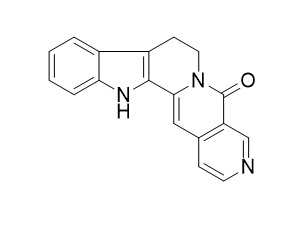Nauclefine
Nauclefine is a plant indole alkaloid natural product and induces apoptosis of diverse cancer cells via a PDE3A-SLFN12 dependent death pathway. Nauclefine binds PDE3A but does not inhibit the PDE3A's phosphodiesterase activity.Nauclefine is an effective inhibitor of BChE.Nauclefine showed potent vasorelaxant activity (more than 90% relaxation at 1 × 10(-5) M) on an isolated rat aorta.
Inquire / Order:
manager@chemfaces.com
Technical Inquiries:
service@chemfaces.com
Tel:
+86-27-84237783
Fax:
+86-27-84254680
Address:
1 Building, No. 83, CheCheng Rd., Wuhan Economic and Technological Development Zone, Wuhan, Hubei 430056, PRC
Providing storage is as stated on the product vial and the vial is kept tightly sealed, the product can be stored for up to
24 months(2-8C).
Wherever possible, you should prepare and use solutions on the same day. However, if you need to make up stock solutions in advance, we recommend that you store the solution as aliquots in tightly sealed vials at -20C. Generally, these will be useable for up to two weeks. Before use, and prior to opening the vial we recommend that you allow your product to equilibrate to room temperature for at least 1 hour.
Need more advice on solubility, usage and handling? Please email to: service@chemfaces.com
The packaging of the product may have turned upside down during transportation, resulting in the natural compounds adhering to the neck or cap of the vial. take the vial out of its packaging and gently shake to let the compounds fall to the bottom of the vial. for liquid products, centrifuge at 200-500 RPM to gather the liquid at the bottom of the vial. try to avoid loss or contamination during handling.
Food Hydrocolloids2024, 57:110432
Int J Mol Sci.2021, 22(16):8604.
Applied Biological Chemistry2024, 67:66.
J Cell Mol Med.2023, jcmm.17968.
Mediators Inflamm. 2016, 2016:6189590
J Pharm Anal.2016, 6(6):363-373
Industrial Crops and Products2022, 188:115596.
Metabolites.2020, 10(12):497.
J AOAC Int.2021, 104(6):1634-1651.
Int J Mol Sci.2019, 20(8):E1855
Related and Featured Products
Fitoterapia . 2022 Jul;160:105228.
Two new neolignans and an indole alkaloid from the stems of Nauclea officinalis and their biological activities[Pubmed:
35667521]
A pair of new diastereoisomers neolignans (1-2) and a new alkaloid (7) were isolated from the stems of Nauclea officinalis: naucleaoxyneolignoside A (1), naucleaoxyneolignoside B (2), (2S,3S)-javaniside (7), together with nine known compounds, 2S-3,3-di-(4-hydroxy-3-methoxyphenyl)-propane-1,2-diol (3), threo-1,2-bis-(4-hydroxy-3-methoxyphenyl)-propane-1,3-diol (4), Nauclefine (5), angustidine (6), naucleoxoside A (8), naucleoxoside B (9), angustoline (10), (3S,19S)-3,14-dihydroangustoline (11), and (3S,19R)-3,14-dihydroangustoline (12).The structures of 1, 2 and 7 were elucidated by extensive spectroscopic methods and the known compounds were identified by comparison of their data with those reported in the literature. The absolution configurations of 1, 2, 7,11 and 12 were confirmed by the quantum chemical CD calculation method. Compounds 1-9 showed weak to moderate inhibitory activity on nitric oxide (NO) production induced by lipopolysaccharide in mouse macrophage RAW 264.7 cells in vitro with IC50 values comparable to that of dexamethasone. In addition, compounds 1-9 were evaluated for the antibacterial and cytotoxic effects, and the results revealed that these compounds showed no anti-bacterial activity, and compounds 3-6 showed modest cytotoxic activity
Molecules . 2012 Apr 2;17(4):4028-4036.
Naucline, a new indole alkaloid from the bark of Nauclea officinalis[Pubmed:
22469596]
A new indole alkaloid, naucline (1) together with four known alkaloids, angustine (2), angustidine (3), Nauclefine (4) and naucletine (5), were isolated from the bark of Nauclea officinalis. The structures of all isolated compounds were elucidated with various spectroscopic methods such as 1D- and 2D- NMR, IR, UV and LCMS-IT-TOF. In addition to that of alkaloid 1, the complete 13C-NMR data of naucletine (5) were also reported. Naucline (1) showed a moderate vasorelaxant activity (90% relaxation at 1 × 10(-5) M) whereas, angustine (2), Nauclefine (4), and naucletine (5) showed potent vasorelaxant activity (more than 90% relaxation at 1 × 10(-5) M) on an isolated rat aorta.
Phytomedicine. 2015 Jan 15;22(1):45-48.
Natural indole butyrylcholinesterase inhibitors from Nauclea officinalis[Pubmed:
CFN91555]
Nine monoterpenoid indole alkaloids; naucletine (1), angustidine (2), Nauclefine (3), angustine (4), naucline (5), angustoline (6), harmane (7), 3,14-dihydroangustoline (8), strictosamide (9) and one quinoline alkaloid glycoside; pumiloside (10) from Nauclea officinalis were tested for cholinesterase inhibitory activity. All the alkaloids except for pumiloside (10) showed strong to weak BChE inhibitory effect with IC50 values ranging between 1.02-168.55 μM. Angustidine (2), Nauclefine (3), angustine (4), angustoline (6) and harmane (7) showed higher BChE inhibiting potency compared to galanthamine. Angustidine (2) was the most potent inhibitor towards both AChE and BChE. Molecular docking (MD) studies showed that angustidine (2) docked deep into the bottom gorge of hBChE and formed hydrogen bonding with Ser 198 and His 438. Kinetic study of angustidine (2) on BChE suggested a mixed inhibition mode with an inhibition constant (Ki) of 6.12 μM.
Nat Commun . 2020 Jun 26;11(1):3236.
An alkaloid initiates phosphodiesterase 3A-schlafen 12 dependent apoptosis without affecting the phosphodiesterase activity[Pubmed:
32591543]
The promotion of apoptosis in tumor cells is a popular strategy for developing anti-cancer drugs. Here, we demonstrate that the plant indole alkaloid natural product Nauclefine induces apoptosis of diverse cancer cells via a PDE3A-SLFN12 dependent death pathway. Nauclefine binds PDE3A but does not inhibit the PDE3A's phosphodiesterase activity, thus representing a previously unknown type of PDE3A modulator that can initiate apoptosis without affecting PDE3A's canonical function. We demonstrate that PDE3A's H840, Q975, Q1001, and F1004 residues-as well as I105 in SLFN12-are essential for Nauclefine-induced PDE3A-SLFN12 interaction and cell death. Extending these molecular insights, we show in vivo that Nauclefine inhibits tumor xenograft growth, doing so in a PDE3A- and SLFN12-dependent manner. Thus, beyond demonstrating potent cytotoxic effects of an alkaloid natural product, our study illustrates a potentially side-effect-reducing strategy for targeting PDE3A for anti-cancer therapeutics without affecting its phosphodiesterase activity.



